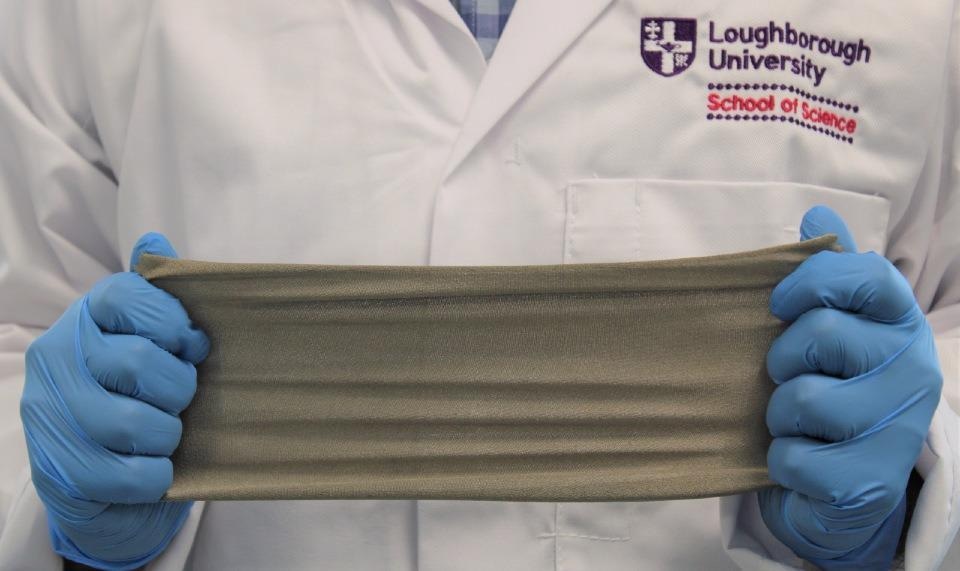Reviewed by Alex SmithApr 22 2022
A new study led by Loughborough University could facilitate clothing that is capable of sensing one’s health, communicating information with others and generating electricity.
 Pictured is the lightweight and thin TENG textile that produced over 35 V of voltage using mild artificial movements. It could potentially power low-power health sensors, environmental sensors, and electronic devices in the near future. Image Credit: Loughborough University
Pictured is the lightweight and thin TENG textile that produced over 35 V of voltage using mild artificial movements. It could potentially power low-power health sensors, environmental sensors, and electronic devices in the near future. Image Credit: Loughborough University
Dr. Ishara Dharmasena, of the School of Mechanical, Electrical and Manufacturing Engineering (MEME), and a group of scientists at the University of Moratuwa (Sri Lanka) have formulated a new, scalable manufacturing method to produce wearable fabrics inserted with tiny power generators called ‘Triboelectric Nanogenerators’ (TENGs).
The method has been illustrated in a paper published in the journal ACS Applied Electronic Materials. This method can transform regular textile materials into ‘energy-generating textiles’ using proven approaches such as dip coating, yarn coating and screen-printing to use triboelectrically active solutions.
The wearable TENG-comprising fabrics are akin in texture to knitted materials used to create t-shirts and jumpers.
But in contrast to a regular pullover, these energy-producing textiles can create electricity to work low-energy electronics using the body’s natural movements.
The 4 cm-by-4 cm lightweight and thin TENG textile developed by the scientists generated more than 35 V of voltage using minor artificial movements that simulated slow body movements, and this could potentially drive the development of low-energy environmental sensors, health sensors and electronic devices.
Dr. Dharmasena states the technology will be “massively beneficial for future smart textile and wearable electronic applications” and could enable the universal shift to remote health tracking.
With this research, we were able to demonstrate that we can use the existing textile materials and common textile manufacturing techniques to produce wearable TENGs with balanced electrical and comfort properties. The all-textile TENG technology we have developed a convenient power source and a self-powered sensor technology— something that may have been seen as science fiction probably a decade ago!
Dr. Ishara Dharmasena, School of Mechanical, Electrical, and Manufacturing Engineering (MEME), Loughborough University
“This work will lead to further research on how we can convert the common textiles into energy-generating clothing for various future applications including healthcare, communication, sports, and personal electronics,” Dr. Dharmasena added.
How It Works
TENG devices gather static charges, similar to those that cause a balloon to adhere to a wall when rubbed against a sweater, or those that give an unexpected shock when one steps on a carpet.
When attached to the clothing or human body, TENG devices ‘vibrate’ or ‘slide’ with movements to develop an electrical signal via a process known as ‘electrostatic induction.’
Scientists have sought to use TENGs in clothing before, but because they are composed of stiff and large plastic sheets and are costly to manufacture, former clothing applications have been unproductive.
Dr. Dharmasena’s method surpasses these problems by integrating new conventional textile materials and judiciously developed TENG device designs.
These devices exhibit enhanced electricity production and meet the majority of durability and comfort requirements for fabric products — a balance that has been quite hard to accomplish thus far in the TENG research domain.
What’s Next
This study is part of Dr. Dharmasena’s Royal Academy of Engineering-sponsored project concentrated on producing sensor-containing super-smart textiles that can be employed for remote health tracking.
He and his contemporaries are currently working toward real-world applications of TENG technology and are eager to hear from academic and industrial partners in the areas of nanotechnology, health sensing technologies, smart textiles and fabrication.
Smart textiles for remote health sensing and energy generation
Smart textiles for remote health sensing and energy generation. (Video Credit: Loughborough University
Journal Reference:
Gunawardhana, K. R. S., et al. (2022) Scalable Textile Manufacturing Methods for Fabricating Triboelectric Nanogenerators with Balanced Electrical and Wearable Properties. ACS Applied Electronic Materials. doi.org/10.1021/acsaelm.1c01095.